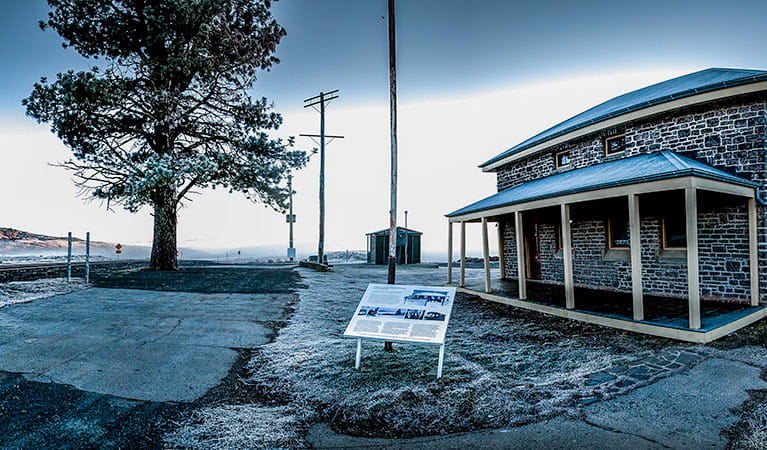Kiandra heritage precinct
Selwyn area in Kosciuszko National Park
Overview
Kiandra heritage precinct buildings are closed due to severe fire damage. Located on the Snowy Mountains Highway, near Adaminaby, Kiandra was home to goldmining and skiing heritage.
- Type
- Historic buildings/places
- Where
- 8950 Snowy Mountains Highway, Kiandra, NSW, 2629 - in Selwyn area in Kosciuszko National Park in Snowy Mountains
Kiandra heritage precinct is open, but all precinct buildings remain closed due to severe fire damage.
Kiandra was the birthplace of snow skiing in Australia and saw the shortest and coldest gold rush in 1860.
A convenient stop along the Snowy Mountains Highway, its heritage buildings and walking track provide insights to the fascinating stories and life in the high country during the 1800s and early 1900s.
Kiandra is also known as an access point to the renowned Australian Alps walking track, and many of central Kosciuszko National Park's walks, cycling and horse riding trails, fishing and camping spots.
Local alerts
For the latest updates on fires, closures and other alerts in this area, see https://www.nationalparks.nsw.gov.au/things-to-do/historic-buildings-places/kiandra-heritage-precinct/local-alerts
General enquiries
- National Parks Contact Centre
- 7am to 7pm daily
- 1300 072 757 (13000 PARKS) for the cost of a local call within Australia excluding mobiles
- parks.info@environment.nsw.gov.au
Park info
- in the Selwyn area of Kosciuszko National Park in the Snowy Mountains region
The Selwyn area is open all year, but some roads and trails may close due to weather conditions or park management issues. Kings Cross Road and the Khancoban-Cabramurra Road are closed in winter (June to October long weekends). Some campgrounds in the Selwyn area close in winter.
-
Park entry fees apply in winter on Link Road
June to October long weekends: $29 per vehicle per day (24hrs from purchase); motorcycles $12; bus passengers $11.45 per adult, $3.60 per child per day (24hrs). Single and Multi-Day passes available from entry stations, NPWS visitor centres, pay machines or via the Park'nPay app.
See vehicle entry fees for other areas in Kosciuszko National Park.
Buy annual pass.
Visitor info
All the practical information you need to know about Kiandra heritage precinct.
Getting there and parking
Kiandra heritage precinct is closed due to severe fire damage.
Road quality
- It's recommended that all vehicles carry snow chains from the June to October long weekends. Read our snow driving in Kosciuszko tips.
- Sealed roads
Vehicle access
- 2WD vehicles
Weather restrictions
- All weather
Maps and downloads
Permitted
Fishing
A current NSW recreational fishing licence is required when fishing in all waters.
Prohibited
Drones
Flying a drone for recreational purposes is prohibited in this area. Drones may affect public enjoyment, safety and privacy, interfere with park operations, or pose a threat to wildlife. See the Drones in Parks policy.
This area may be a declared Drone Exclusion Zone, or may be subject to Civil Aviation Safety Authority (CASA) rules for flying near airports, aerodromes and helicopter landing sites. See CASA's Drone Flyer Rules.
Commercial filming and photography
Commercial filming or photography is prohibited without prior consent. You must apply for permission and contact the local office.
Pets
Pets and domestic animals (other than certified assistance animals) are not permitted. Find out which regional parks allow dog walking and see the pets in parks policy for more information.
If you're transiting through a national park or reserve on a public road, pets must remain within the vehicle.
Smoking
NSW national parks are no smoking areas.
Learn more
Kiandra heritage precinct is in Selwyn area. Here are just some of the reasons why this park is special:
Kiandra's claims to fame
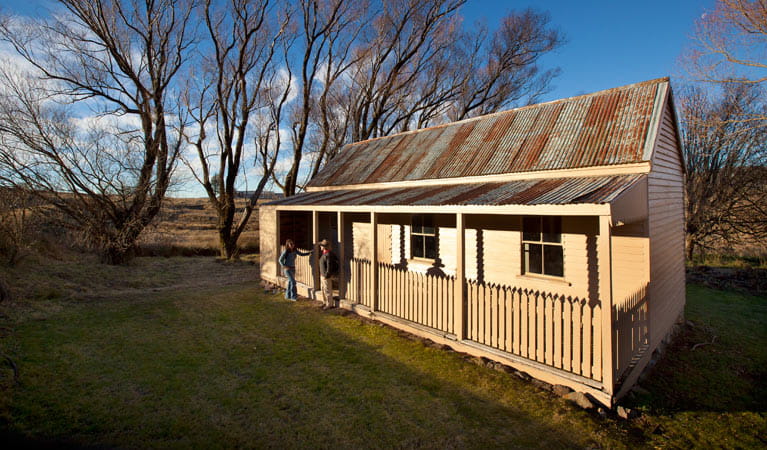
The discovery of gold at Kiandra in 1859 attracted up to 10,000 prospectors hoping to strike it rich. Just 18 months later, after harsh winters and falling gold finds, only a few hundred gold miners remained. It's remembered as one of Australia’s shortest gold rushes, not to mention it’s highest (and coldest). In 1861, Kiandra became the birthplace of skiing in Australia, when Norwegian gold miners fashioned skis from fence palings. By the 1870s regular ski carnivals were arranged, and Australia had its first official ski slope here. Mining continued into the 1930s, with grazing and winter skiing also keeping the community alive. Before devastating fires in 2019-2020, four buildings still stood here, including Kiandra Courthouse, which had served as a courthouse, private residence, ski chalet, hotel and bar.
Plants and animals protected in this park
Animals
-

Bare-nosed wombat (Vombatus ursinus)
A large, squat marsupial, the Australian bare-nosed wombat is a burrowing mammal found in coastal forests and mountain ranges across NSW and Victoria. The only other remaining species of wombat in NSW, the endangered southern hairy-nosed wombat, was considered extinct until relatively recently.
-
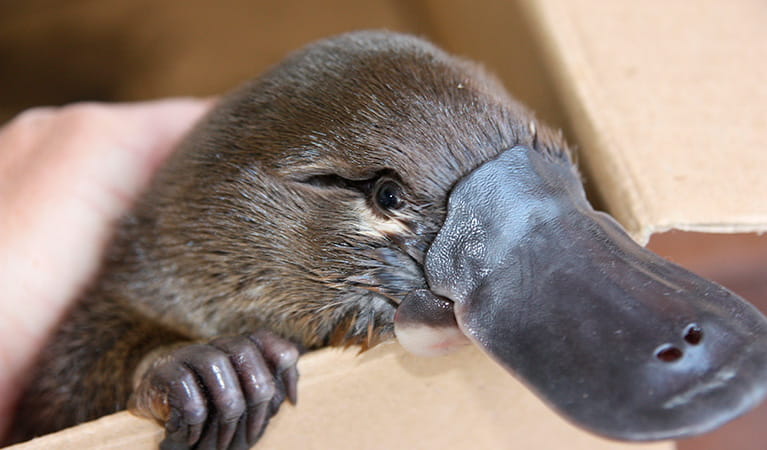
Platypus (Ornithorhynchus anatinus)
One of the most fascinating and unusual Australian animals, the duck-billed platypus, along with the echidna, are the only known monotremes, or egg-laying mammals, in existence. The platypus is generally found in permanent river systems and lakes in southern and eastern NSW and east and west of the Great Dividing Range.
-
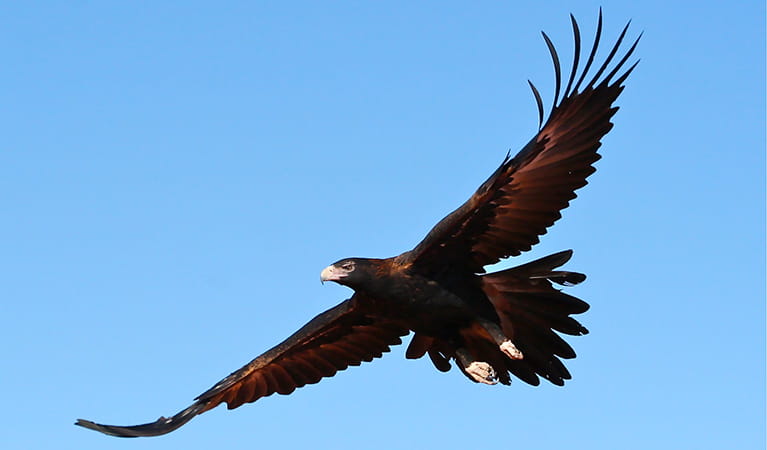
Wedge-tailed eagle (Aquila audax)
With a wingspan of up to 2.5m, the wedge-tailed eagle is Australia’s largest bird of prey. These Australian animals are found in woodlands across NSW, and have the ability to soar to heights of over 2km. If you’re bird watching, look out for the distinctive diamond-shaped tail of the eagle.
Plants
-
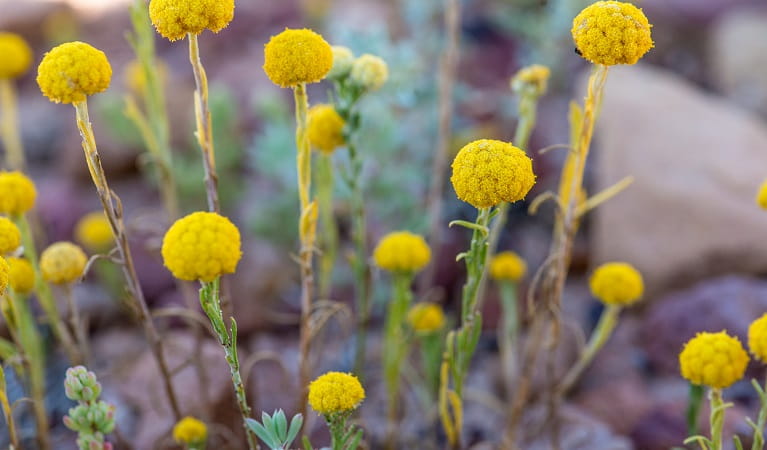
Billy buttons (Craspedia spp. )
Billy buttons are attractive Australian native plants that are widespread throughout eastern NSW in dry forest, grassland and alpine regions such as Kosciuszko National Park. The golden-yellow globe-shaped flowers are also known as woollyheads. Related to the daisy, billy buttons are an erect herb growing to a height of 50cm.

